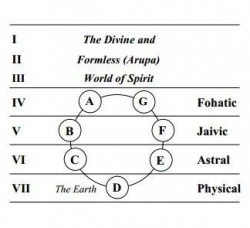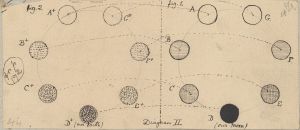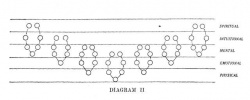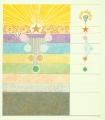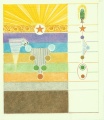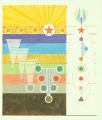Planetary Chain
A Planetary chain is a group of seven "globes", "spheres", or "planets" linked together into a single scheme of evolution. According to Mme. Blavatsky "there are seven [chains] in our system."[1]
Planetary Chains
The concept of Planetary chains was first published in 1883 by Alfred Percy Sinnett in his book Esoteric Buddhism. He wrote:
The life and evolutionary processes of this planet . . . are linked with the life and evolutionary processes of several other planets. . . . One globe does not afford Nature scope for the processes by which mankind has been evoked from chaos, but these processes do not require more than a limited and definite number of globes. Separated as these are, in regard to the gross mechanical matter of which they consist, they are closely and intimately bound together by subtle currents and forces, whose existence reason need not be much troubled to concede, since the existence of some connection - of force or ethereal media - uniting all visible celestial bodies, is proved by the mere fact that they are visible. It is along these subtle currents that the life elements pass from world to world.[2]
The "planetary chain" is composed by seven globes that can be represented as in a circular configuration. In the words of Mahatma K. H.:
Now, the congeries of the star-worlds (including our own planet) inhabited by intelligent beings may be likened to an orb or rather an epicycloid formed of rings like a chain — worlds inter-linked together, the totality representing an imaginary endless ring, or circle.[3]
These globes are not all on the same plane of perception. H. P. Blavatsky explains:
The one eternal LAW unfolds everything in the (to be) manifested Nature on a sevenfold principle; among the rest, the countless circular chains of worlds, composed of seven globes, graduated on the four lower planes of the world of formation (the three others belonging to the Archetypal Universe). Out of these seven only one, the lowest and the most material of those globes, is within our plane or means of perception, the six others lying outside of it and being therefore invisible to the terrestrial eye. Every such chain of worlds is the progeny and creation of another, lower, and dead chain—its reincarnation, so to say.[4]
It will be seen that the fourth member of a series occupies a unique position. Unlike the others, the Fourth has no “sister” Globe on the same plane as itself, and it thus forms the fulcrum of the “balance” represented by the whole chain. It is the sphere of final evolutionary adjustments, the world of Karmic scales, the Hall of Justice, where the balance is struck which determines the future course of the Monad during the remainder of its incarnations in the cycle.[5]
In the Theosophical literature the two highest globes on the descending and ascending arcs respectively are denominated A and G (or Z). The globes on the next lower plane are B and F, the next pair are denominated C and E, and the lowest of all is the globe D. Although Mr Sinnett published that globes C and E were also physical, Blavatsky rejected this view and said that only the earth was the physical globe of the chain (see below Controversy about Mars and Mercury).
Planetary Chain and the Tree of Life
In The Secret Doctrine Mme. Blavatsky compared the Theosophical teachings about the different globes with the sephiroth that form the Tree of Life:
The following comparative diagram shows the identity between the two systems, the Kabalistic and the Eastern. The three upper are the three higher planes of consciousness, revealed and explained in both schools only to the Initiates, the lower ones represent the four lower planes—the lowest being our plane, or the visible Universe.
These seven planes correspond to the seven states of consciousness in man.[6]
Our Globe, as taught from the first is at the bottom of the arc of descent, where the matter of our perceptions exhibits itself in its grossest form. . . . . . . Hence it only stands to reason that the globes which overshadow our Earth must be on different and superior planes. In short, as Globes, they are in CO-ADUNITION but not IN CONSUBSTANTIALITY WITH OUR EARTH and thus pertain to quite another state of consciousness.[7]
Regarding the planes shown in the diagram, she wrote:
The Arupa or “formless,” there where form ceases to exist, on the objective plane.
The word “Archetypal” must not be taken here in the sense that the Platonists gave to it, i.e., the world as it existed in the Mind of the Deity; but in that of a world made as a first model, to be followed and improved upon by the worlds which succeed it physically—though deteriorating in purity.
These are the four lower planes of Cosmic Consciousness, the three higher planes being inaccessible to human intellect as developed at present.[8]
Controversy about Mars and Mercury
In his correspondence with the Mahatmas K. H. and M., Mr. Sinnett asked the following question:
What other planets of those known to ordinary science, besides Mercury, belong to our system of worlds?
Are the more spiritual planets — (A, B & Y, Z) — visible bodies in the sky or are all those known to astronomy of the more material sort?[9]
The answer from Mahatma K.H. was the following:
Mars and four other planets of which astronomy knows yet nothing. Neither A, B, nor Y, Z, are known; nor can they be seen through physical means however perfected.[10]
From this, Mr. Sinnett naturally assumed that Mars, Mercury, and the Earth where all part of the same septenary chain of globes, as he published in his Esoteric Buddhism:
Besides the earth, which is at the lowest material point, there are only two other worlds of our chain which are visible to physical eyes--the one behind and the one in advance of it. These two worlds, as a matter of fact, are Mars and Mercury--Mars being behind and Mercury in advance of us--Mars in a state of entire obscuration now as regards the human life-wave, Mercury just beginning to prepare for its next human period. . . . The two planets of our chain that are behind Mars, and the two that are in advance of Mercury, are not composed of an order of matter which telescopes can take cognizance of. Four out of the seven are thus of an ethereal nature, which people who can only conceive matter in its earthly form will be inclined to call immaterial. But they are not really immaterial at all.[11]
Sinnett felt confident that his interpretation of the teachings was overall correct, since Mahatma K.H. himself assured him that there were no fundamental mistakes in his book, and that later teachings were not going to clash with what he wrote:
Be certain, that with a few undetectable mistakes and omissions notwithstanding, your Esoteric Buddhism is the only right exposition — however incomplete — of our Occult doctrines. You have made no cardinal, fundamental mistakes; and whatever may be given to you hereafter will not clash with a single sentence in your book but on the contrary will explain away any seeming contradiction.[12]
However, a few years later H. P. Blavatsky wrote in The Secret Doctrine that the notion that Mars and Mercury are part of our Chain was a "great mistake":
This was a great mistake. But the blame for it is to be attached as much to the vagueness and incompleteness of the Master’s answer as to the question of the learner itself, which was equally vague and indefinite.
It was asked: “What planets, of those known to ordinary science, besides Mercury, belong to our system of worlds?” Now if by “System of Worlds” our terrestrial chain or “string” was intended in the mind of the querist, instead of the “Solar System of Worlds,” as it should have been, then of course the answer was likely to be misunderstood. For the reply was: “Mars, etc., and four other planets of which astronomy knows nothing. Neither A, B, nor YZ are known nor can they be seen through physical means however perfected.” As to Mars, Mercury, and “the four other planets,” they bear a relation to Earth of which no master or high Occultist will ever speak, much less explain the nature . . . But neither Mars nor Mercury belong to our chain. They are, along with the other planets, septenary Units in the great host of “chains” of our system, and all are as visible as their upper globes are invisible.[13]
It is not clear what relation these planets bear to Earth.
Annie Besant's interpretation
In 1895 Annie Besant was asked about this matter. Her answer was as follows:
The facts are these; the planetary chain consists of Globes A., B., Mars, Earth, Mercury, F., and G., and round these the great life-wave has swept three and a half times, reaching Earth for the fourth time; the mass of humanity passed from Mars to the Earth, and will pass from the Earth to Mercury. But the leading class of humanity — and here is a fact that throws some light on the opposing statements — did not share in this general evolution. It came directly to the Earth from another region at a much later period in evolution, and had never been on Mars at all. Another fact, which H.P.B. evidently had in mind, when writing on this question, is that Mars is also concerned in an entirely different evolution, as to which nothing can be publicly said. It is therefore impossible to clear the matter up to the satisfaction of exoteric students, but it is just that it should be publicly stated that Mr. Sinnett's statement is entirely borne out by the original letter.[14]
Annie Besant, C. W. Leadbeater and C. Jinarajadasa continued to maintain that Mars and Mercury are part of the earth chain[15] while other Theosophists such as W. Q. Judge and Robert Crosbie regarded them as the globe D of different chains. G. de Purucker also maintained this position, although he introduced five more globes to the planetary chains, thus making them consist of 12 globes.
G. de Purucker's interpretation
In his work The Twelve Sacred Planets, David Pratt presents G. de Purucker's view in the following way:
He points out that ‘our system of worlds’ can refer to our universal solar system (i.e. all the solar systems revolving around the same raja-sun as our own), our planetary chain, our group of seven sacred planets, and to ‘this mystery-group – Earth, Mercury, Mars, and four other secret planets’. KH’s generalized reply refers in particular to this latter group, because Sinnett had just been questioning KH ‘on a certain aspect of the teachings which could not be fully explained without giving out the doctrine concerning this mystery-group’.
GdeP explains that many planetary chains in our solar system and universal solar system have no globes on our own plane of perception. All the countless planetary chains, visible and invisible, are divided into families of seven (or twelve), whose members are closely related karmically. Referring to our own sacred planets, he writes:
- [The] seven sacred planets are profoundly instrumental in building our planetary chain; but the earth also itself is one of another group or series of seven planets, which build or cooperate in building the planetary chain of certain other ones of our planets...
- Earth, Mercury, Mars, and the four secret planets are a septenary group ‘whose function is to act in building another planetary chain’.
- Our own planetary chain helps to build and guide one of the other planetary chains in particular but all the other planetary chains of our solar system in general. Mars, for example, is built by its particular group of seven or twelve planetary chains, itself being the eighth of its ogdoad, and our Earth chain is one of these. Not all of the seven sacred planets of any of the planets in our solar system would necessary be our own sacred planets.[16]
Rebirth of a new chain
In The Secret Doctrine Mme. Blavatsky explains that as the evolution in a chain is coming to an end, it begin to "die" and its principles are transferred to a new one, in what can be compared with a process of "reincarnation":
It is said that the planetary chains having their "Days" and their "Nights"—i.e., periods of activity or life, and of inertia or death—and behave in heaven as do men on Earth: they generate their likes, get old, and become personally extinct, their spiritual principles only living in their progeny as a survival of themselves. Without attempting the very difficult task of giving out the whole process in all its cosmic details, enough may be said to give an approximate idea of it. When a planetary chain is in its last Round, its Globe 1 or A, before finally dying out, sends all its energy and “principles” into a neutral centre of latent force, a “laya centre,” and thereby informs a new nucleus of undifferentiated substance or matter, i.e., calls it into activity or gives it life.[17]
These globes are formed by a process which the Occultists call the “rebirth of planetary chains (or rings).” When the seventh and last of one of such rings has been entered upon, the highest or first globe “A,” followed by all the others down to the last, instead of entering upon a certain time of rest—or “obscuration,” as in their previous Rounds—begins to die out. The “planetary” dissolution (pralaya) is at hand, and its hour has struck; each globe has to transfer its life and energy to another planet.[18]
She explains the process taking as an example the end of the previous chain (of which the moon was the globe D) and the beginning of the Earth-chain:
In the Seventh Round on the Lunar chain, when Class 7 [of Monads], the last, quits Globe A, that Globe, instead of falling asleep, as it had done in previous Rounds, begins to die (to go into its planetary pralaya); and in dying it transfers successively, as just said, its “principles,” or life-elements and energy, etc., one after the other to a new “laya-centre,” which commences the formation of Globe A of the Earth Chain. A similar process takes place for each of the Globes of the “lunar chain” one after the other, each forming a fresh Globe of the “earth-chain.” Our Moon was the fourth Globe of the series, and was on the same plane of perception as our Earth. But Globe A of the lunar chain is not fully “dead” till the first Monads of the first class have passed from Globe G or Z, the last of the “lunar chain,” into the Nirvana which awaits them between the two chains; and similarly for all the other Globes as stated, each giving birth to the corresponding globe of the “earth-chain.”[19]
It is Fohat who guides the transfer of the principles from one planet to the other, from one star to another—child-star. When a planet dies, its informing principles are transferred to a laya or sleeping centre, with potential but latent energy in it, which is thus awakened into life and begins to form itself into a new sidereal body.[20]
Teachings of Annie Besant and C. W. Leadbeater
Schemes of evolution
In the teachings of Annie Besant and C. W. Leadbeater the Earth Chain is the fourth in a larger scheme composed of seven chains:
A scheme of Evolution passes through seven great evolutionary stages, each of which is called a Chain. This name is derived from the fact that a Chain consists of seven Globes, mutually interrelated; it is a chain of seven links, each link a globe. . . . In [the diagram] we have a single Scheme, figured in the seven stages of its evolution, i.e., in its seven successive Chains; it is now shown in relation to five of the seven spheres, or types, of matter existing in the Solar System . . . this matter is named according to the mood of consciousness to which it responds: physical, emotional, mental, intuitional, spiritual.
In their model, during the first half of the scheme, each new chain becomes more material, its globes descending one plane at a time. During the second half the chains become more spiritual again:
In the first Chain, its seven Worlds, A, B, C, D, E, F, G, are seen arranged: A and G, the root-world and the seed-world, are on the spiritual plane, for all descends from the higher to the lower, from the subtle to the dense, and climbs again to the higher, enriched with the gains of the journey, the gains serving as seed for the next Chain; B and F are on the intuitional plane, one gathering and the other assimilating; C and E are on the higher mental, in similar relationship; D, the turning point, the point of balance between the ascending and descending arcs, is in the lower part of the mental plane. These pairs of globes in every Chain are ever closely allied, but the one is the rough sketch, the other the finished picture. In the second Chain, the globes have all sunk one stage lower into matter, and D is on the emotional plane. In the third Chain, they have sunk yet one stage further, and D reaches the physical plane. In the fourth Chain, and on the fourth only, the midmost Chain of the seven, the most deeply involved in densest matter, the turning point of the Chains as is D of the globes, there are three of the globes-- C, D, and E-- on the physical plane. On the return journey, as it were, the ascent resembles the descent: in the fifth Chain, as in the third, there is one physical globe; in the sixth, as in the second, globe D is emotional; in the seventh, as in the first, globe D is mental. With the ending of the seventh Chain the Scheme has worked itself out, and its fruitage is harvested.
Although some planets of the chain are on the astral and mental planes, this does not mean they are within the earth's astral or mental atmosphere. C. W. Leadbeater wrote:
Each physical globe has its physical plane (including its atmosphere), its astral plane, and its mental plane, all interpenetrating one another, and therefore occupying the same position in space, but all quite apart from and not communicating with the corresponding planes of any other globe. It is only when we rise to the lofty levels of the buddhic plane that we find a condition common to, at any rate, all the planets of our chain. . . . A clear comprehension of these facts will prevent the confusion that has sometimes been made by students between the mental plane of our earth and those other globes of our chain which exist on the mental plane. It must be understood that the seven globes of our chain are real globes, occupying definite and separate positions in space, notwithstanding the fact that some of them are not up in the physical plane. Globes A, B, F, and G are separate from us and from one another just in the same way as are Mars and the earth; the only difference is that whereas the latter have physical, astral and mental planes of their own, globes B and F have nothing below the astral plane, and A and G nothing below the mental. The astral plane dealt with in Manual V and the mental plane which we are about to consider are those of this earth only, and have nothing to do with these other planets at all.[21]
Teachings of G. de Purucker
In his Occult Glossary, G. de Purucker explains the following:
Every kosmic body or globe, be it sun or planet, nebula or comet, atom or electron, is a composite entity formed of or comprised of inner and invisible energies and substances and of an outer, to us, and often visible, to us, physical vehicle or body. These elements all together number seven (or twelve), being what is called in theosophy the seven principles or elements of every self-contained entity; in other words, of every individual life-center.
Thus every one of the physical globes that we see scattered over the fields of space is accompanied by six invisible and superior globes, forming what in theosophy is called a chain. This is the case with every sun or star, with every planet, and with every moon of every planet. It is likewise the case with the nebulae and the comets as above stated: all are septiform entities, all have a sevenfold constitution, even as man has, who is a copy in the little of what the universe is in the great, there being for us one life in that universe, one natural system of "laws" in that universe. Every entity in the universe is an inseparable part of it; therefore what is in the whole is in every part, because the part cannot contain anything that the whole does not contain, the part cannot be greater than the whole.
Our own earth-chain is composed of seven (or twelve) globes, of which only one, our earth, is visible on this our earth plane to our physical sense apparatus, because that apparatus is builded or rather evolved to cognize this earth plane and none other. But the populations of all the seven (or twelve) globes of this earth-chain pass in succession, and following each other, from globe to globe, thus gaining experience of energy and matter and consciousness on all the various planes and spheres that this chain comprises.
The other six (or eleven) globes of our earth-chain are invisible to our physical sense, of course; and, limiting our explanation only to the manifest seven globes of the complete chain of twelve globes, the six globes other and higher than the earth exist two by two, on three planes of the solar system superior to our physical plane where our earth-globe is — this our earth. These three superior planes or worlds are each one superior to the world or plane immediately beneath or inferior to it.
Our earth-globe is the fourth and lowest of all the manifest seven globes of our earth-chain. Three globes precede it on the descending or shadowy arc, and three globes follow it on the ascending or luminous arc of evolution. The Secret Doctrine by H. P. Blavatsky and the more recent work, Fundamentals of the Esoteric Philosophy (1932), contain most suggestive material for the student interested in this phase of the esoteric philosophy.[22]
Artistic representations
Theosophist James S. Perkins, in his book Visual Meditations on the Universe[23] publishes five original paintings representing the evolution of the "Earth Scheme" inspired by the teachings of Annie Besant and C. W. Leadbeater on the subject.
The horizontal colored bars represent the planes as follows:
- Purple: atmic plane
- Light blue: buddhic plane
- Yellow: higher mental plane
- Green: lower mental plane
- Orange: astral plane
- Grey: etheric plane
- Brown: physical dense plane
Online resources
Articles
- Chain, Planetary in Theosophy World
- Ogdoad in Theosophy World
- The Earth Chain of Globes, Part I, I, and Part III by William Q. Judge
- How to Square the Teachings by William Q. Judge
- Mars and Mercury by William Q. Judge
- The Planetary Chain by G.R.S. Mead
- Esoteric Teaching A response to Judge's "Mars and Mercury" by A. P. Sinnett
- Blavatsky Letter to Sinnett - LBS No. 39 in The Letters of H. P. Blavatsky to A. P. Sinnett.
Notes
- ↑ Helena Petrovna Blavatsky, The Secret Doctrine vol. II, (Wheaton, IL: Theosophical Publishing House, 1993), 311.
- ↑ Alfred Percy Sinnett, Esoteric Buddhism (London: The Theosophical Publishing House Ltd, 1972), 29.
- ↑ Vicente Hao Chin, Jr. Mahatma Letters to A. P. Sinnett in chronological sequence No. 18 (Quezon City: Theosophical Publishing House, 1993), 64.
- ↑ Helena Petrovna Blavatsky, The Secret Doctrine vol. I (Wheaton, IL: Theosophical Publishing House, 1993), 152.
- ↑ Helena Petrovna Blavatsky, The Secret Doctrine vol. I (Wheaton, IL: Theosophical Publishing House, 1993), 182.
- ↑ Helena Petrovna Blavatsky, The Secret Doctrine vol. I, (Wheaton, IL: Theosophical Publishing House, 1993), 199.
- ↑ Helena Petrovna Blavatsky, The Secret Doctrine vol. I, (Wheaton, IL: Theosophical Publishing House, 1993), 166.
- ↑ Helena Petrovna Blavatsky, The Secret Doctrine vol. I, (Wheaton, IL: Theosophical Publishing House, 1993), 200, fn.
- ↑ Vicente Hao Chin, Jr. Mahatma Letters to A.P. Sinnett in chronological sequence No. 93A (Quezon City: Theosophical Publishing House, 1993), 307
- ↑ Vicente Hao Chin, Jr. Mahatma Letters to A.P. Sinnett in chronological sequence No. 93B (Quezon City: Theosophical Publishing House, 1993),331
- ↑ Alfred Percy Sinnett, Esoteric Buddhism (London: The Theosophical Publishing Hourse LTD, 1972), 136-137.
- ↑ Vicente Hao Chin, Jr., The Mahatma Letters to A.P. Sinnett in chronological sequence No. 113 (Quezon City: Theosophical Publishing House, 1993), 389.
- ↑ Helena Petrovna Blavatsky, Secret Doctrine vol. I, (Wheaton, Ill: Theosophical Publishing House, 1993), 163
- ↑ Annie Besant, Lucifer Vol. XVII, No. 100 (London: Theosophical Publishing Society, December 1895), 271.
- ↑ Annie Besant and Charles Webster Leadbeater, Man: Whence How and Whither A Record of Clairvoyant Investigation (Adyar: The Theosophical Publishing House, 1913), 4
- ↑ Mars/Mercury controversy by David Pratt, 2007
- ↑ Helena Petrovna Blavatsky, The Secret Doctrine vol. I, (Wheaton, IL: Theosophical Publishing House, 1993), 154-155.
- ↑ Helena Petrovna Blavatsky, The Secret Doctrine vol. I (London: The Theosohpical Publishing House, 1978), 159
- ↑ Helena Petrovna Blavatsky, The Secret Doctrine vol. I (London: The Theosohpical Publishing House, 1978), 171-173.
- ↑ Helena Petrovna Blavatsky, The Secret Doctrine vol. I, (Wheaton, IL: Theosophical Publishing House, 1993), 147.
- ↑ C. W. Leadbeater, The Devachanic Plane
- ↑ Gottfried de Purucker, Occult Glossary (Pasadena, CA: Theosophical University Press, 1996), 129.
- ↑ James S. Perkins, Visual Meditations on the Universe (Wheaton, IL:Theosophical Publishing House, 1984), 128 pp.

